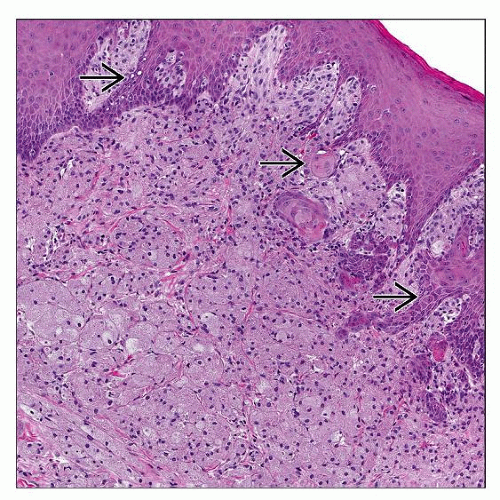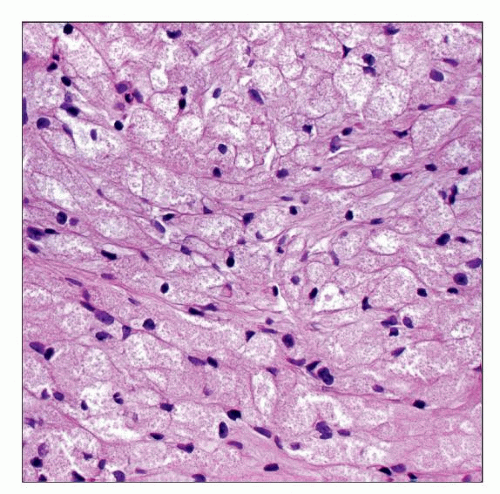Granular Cell Tumor
Cyril Fisher, MD, DSc, FRCPath
Key Facts
Terminology
Benign tumor composed of poorly demarcated accumulation of plump granular cells
Thought to arise from Schwann cells
Granular cell myoblastoma
Clinical Issues
Female > male (2:1)
Blacks affected more often than whites
Up to 70% of head and neck lesions develop in oral cavity (tongue most common)
Up to 20% of patients will have multifocal disease
Recurrence/relapse/persistence is uncommon (˜ 10%)
Macroscopic Features
Cut surface is firm, pale-cream colored
Microscopic Pathology
Unencapsulated plump, polygonal to elongated granular cells blending with adjacent soft tissues, especially skeletal muscle
Cells show indistinct cell membranes, abundant granular, eosinophilic cytoplasm, and small hyperchromatic nuclei
Overlying pseudoepitheliomatous hyperplasia is common
Ancillary Tests
Granules are PAS(+), diastase resistant
Strongly and uniformly positive for S100, NSE
Top Differential Diagnoses
Squamous cell carcinoma, rhabdomyoma, schwannoma, congenital epulis of newborn
TERMINOLOGY
Abbreviations
Granular cell tumor (GCT)
Synonyms
Granular cell myoblastoma
Abrikossoff tumor
Definitions
Benign tumor composed of poorly demarcated proliferation of plump granular cells
Distinct from congenital epulis of newborn (gingival granular cell tumor of infancy)
ETIOLOGY/PATHOGENESIS
Schwannian Derivation
Thought to arise from Schwann cells
Positive with neural-associated antibodies
Granules represent senescent change with accumulation of autophagocytic lysosomes
CLINICAL ISSUES
Epidemiology
Incidence
Rare
Age
All ages
Peak between 40-60 years
Gender
Female > male (2:1)
Ethnicity
Blacks affected more often than whites
Site
Over 50% occur in head and neck region
Up to 70% of these develop in oral cavity (mucosa, tongue, hard palate)
Tongue is most common site
Dorsum more often than lateral margin
Skin
Nerve
Esophagus
Biliary tract
Neurohypophysis
Up to 20% of patients have multiple lesions
Presentation
Most present as a single painless nodule
Usually have symptoms for < 12 months
Rarely, may present with Eagle syndrome
Elicitation of pain on swallowing, turning head, or extending tongue
Syndrome is thought to be caused by irritation of glossopharyngeal nerve
Treatment
Surgical approaches
Complete excision with narrow margins
Laser excision can be performed
Prognosis
Excellent long-term prognosis
Recurrence/relapse/persistence is uncommon (˜ 10%)
Malignant GCTs very rare
Local recurrence in more than 30%
50% metastasize, mainly to lymph nodes, lung, bone
MACROSCOPIC FEATURES
General Features
Size
Mean: 1-2 cm
MICROSCOPIC PATHOLOGY
Histologic Features






